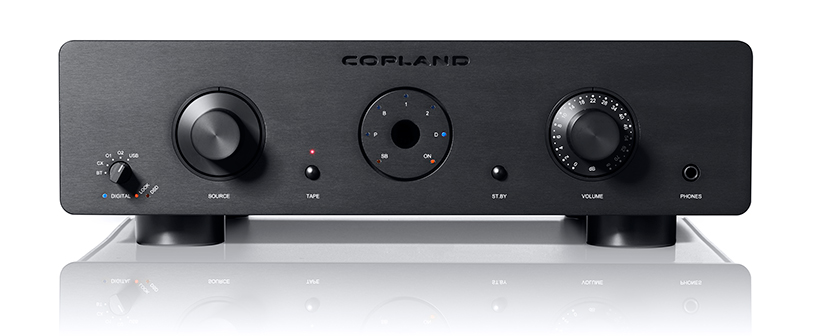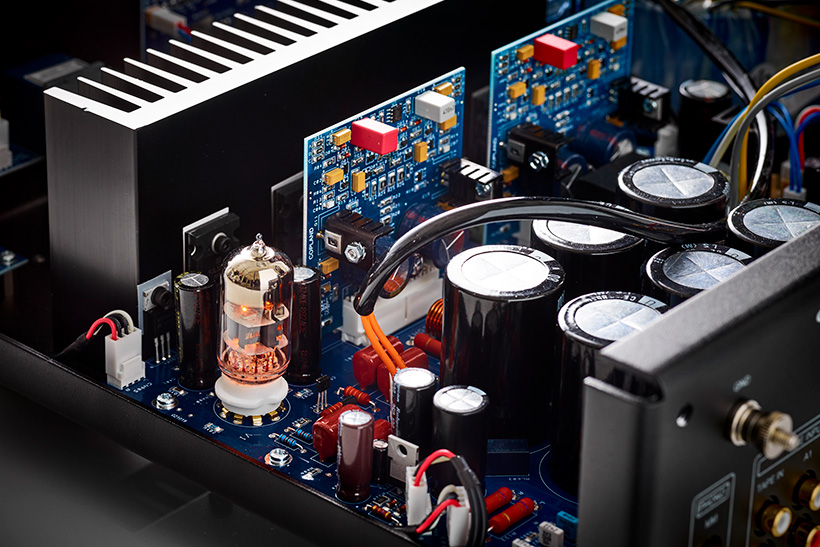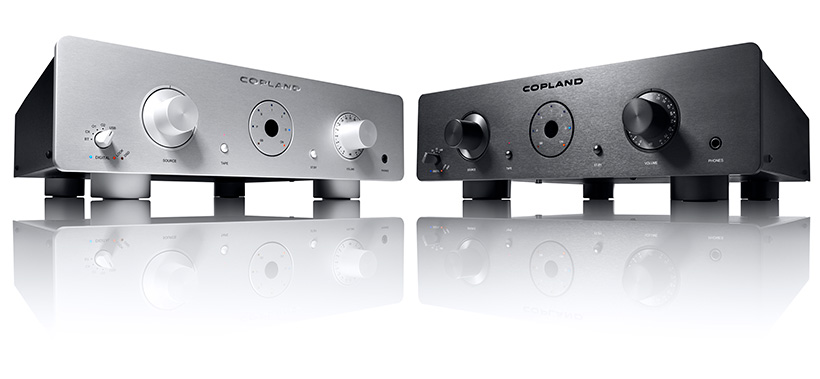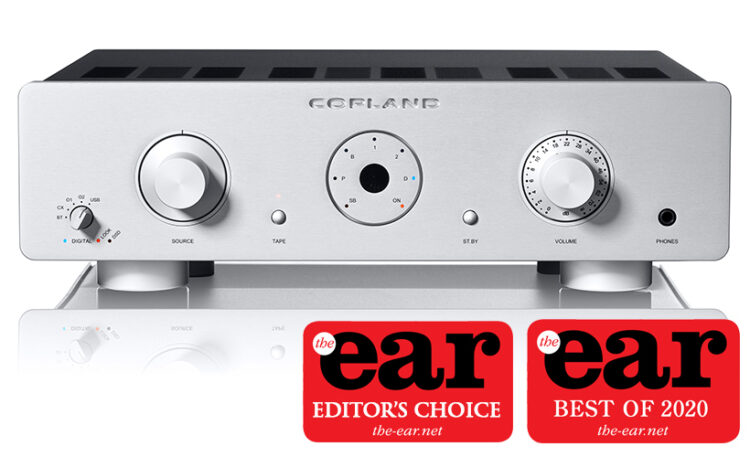The Scandinavian countries have between them produced some iconic audio brands – I bet if you put your mind to it you could name at least half a dozen without hesitation. Copland would certainly be on my list if I was to do the same thing, and yet this is the first time that I have had the pleasure of hosting one of their devices in my system. My view was that they produce mostly valve-based amplifiers and CD players which have garnered great (I nearly said glowing, but even I winced at that) reviews from respected publications around the world. Their latest creation is the CSA 100 integrated amplifier, which they describe on their rather minimalist website as a hybrid. It is distributed in the UK by Absolute Sounds, whose catalogue is testimony to their commitment to bringing true high end audio to the market here.
What does hybrid mean in this context, to start with, the power amplification system is very much based on solid state technology. MosFETs deliver a meaty 100 Watts a side, while the preamplifier section sports a single dual-triode valve, chosen for the sweetness that it contributes to the overall sound. That however, is jumping ahead. First it is worth observing just how well equipped this Danish delight is, with plenty of input options, including a tape monitor loop, two pairs of RCA sockets and a pair of balanced XLRs, a moving magnet compatible phono stage and an ESS DAC with optical, coaxial and USB inputs. In addition to the tape out there is also a pair of preamp-outputs. The only optional extra is an aptX HD Bluetooth module but as the review sample was not fitted with Bluetooth it didn’t feature in my listening. In the CSA 100 hybrid means not only valve and solid state but also analogue and digital – it’s a comprehensive package. The review sample was finished in an extremely attractive matt silver, which means that fingerprints will not be an issue. Black is also available.

On the front, from the left, is digital source selector with a blue LED that lights when the DAC has been selected on the master source dial, and an orange LED that glows once a digital source has been locked in. Next is a large rotary dial from which source is selected, it’s marked P (phono), B (balanced), 1 and 2 (RCA analogue inputs) and D (digital). Here too are orange LEDs which signify whether the unit is in standby mode or fully powered up. On the right is the rotary volume control and midway between the three large circles are tape and standby buttons. Finally, on the far right is a full-size headphone socket. The symmetry of the fascia appealed to me greatly.
RTM
As I always do, I read the manual cover to cover before connecting anything to the unit (really? – Ed). In this case, I learned that the CSA 100 is phase inverted, which means reversing the black and red speaker cables at the amplifier. I used two different loudspeakers during the review period, Harbeth C7 XDs and Dynaudio Super Forty Anniversary editions. The CSA 100 brought out the best in both.
I then connected my Linn LP12 with a Goldring 1042 cartridge fitted to the Ittok arm to the phono stage inputs and took the digital out from a Lyngdorf CD2 into the coaxial input of the Copland’s DAC with a Tellurium Q digital RCA cable. My TV was connected to one of the optical inputs. For power I plugged in the Shunyata Delta NR-V2, which was plugged directly into a wall socket. Satisfied that everything was where it should be I switched on the Copland, elected D on the input dial then switched the digital source sector to CX. It takes about 30 seconds for the amplifier to be ready, as the solitary valve gets up to operating temperature.

Sound quality
I inserted a CD of Burning for Buddy which features the Buddy Rich Big Band with a selection of guest drummers. Produced by the late Neil Peart of Rush in 1994, and released on Atlantic, this has recently been getting a lot of play here. It’s thoroughly recommended but sadly out of print and used examples are eye-waveringly expensive. It is a tribute to a great drummer by lots of the great drummers who were still around in 1994, supported by some exceptional big band playing.
Even stone cold out of the box, it was obvious that I was in for a fun time with the Copland. The Harbeths were singing with bass that was plentiful but well controlled, a really rich yet detailed midrange and a wonderfully light and airy top end. Track one starts with Simon Phillips starting with some delicate high hat work before the band jumps in on Dancing Men. The Copland, even at this early stage, delivered with total credibility. I also tried the CD2 with analogue out to the Copland using good quality RCA interconnects. Overall I slightly preferred the sound via the Copland’s DAC, though there was not much in it. However, that was how I listened to CD for the most part as it did sound that tiny bit more enjoyable.
The silver, slightly lozenge-shaped remote control supplied with the CSA 100 has a rubber bumper round its mid-section and well-marked decent sized buttons for source selection and volume control. It will also control a Copland CD player should you pair one with the amplifier. What it does not do is allow switching between digital inputs. That requires a walk to the equipment rack and hands-on action.

The next disc I chose was another tribute to a lost musical hero, in this case Peter Green, whose death had only recently been reported. I have a double CD called Rattlesnake Guitar that was sponsored by Gibson USA, this dates back to the mid 90s and features a variety of guitar luminaries playing songs from Green’s extensive repertoire. Track one, disc one features Larry McCray performing Black Magic Woman. Crisp guitar, strong vocals, foot-tapping rhythm, great bass, all present and correct.
Over the next day or two the Copland opened up even more. I started to listen to vinyl via the built-in phono-stage. Sometimes these can feel like an afterthought, added so that some marketing guru’s checklist of features is complete. Not with the Copland – vinyl replay through this was genuinely enjoyable. This produced a pile of albums that grew to some depth in my room. Was it as good as my £2k separate stage? Well it may have lost a tiny bit of dynamic impact, a little bit of immediacy, but quite honestly it was more than good enough to be paired with any moving magnet cartridge and satisfy 99.9 per cent of owners.
The ESS DAC is again a first class implementation. As I have already said, CD replay through it was extremely pleasing. TV sound, delivered through the optical interface, was clear and detailed, with action soundtracks being delivered with verve. Dialogue was crisp and easy to follow. The CSA 100 does all those hi-fi things extraordinarily well. The soundstage it creates is as wide, deep and tall as the loudspeakers will permit. While driving music forward effortlessly it easily picks up and presents to the listener micro-details that are sometimes sacrificed by less competent amplifiers. Rock music had real drive while at the other end of the spectrum solo cello had warmth and immediacy.

Conclusion
In the last year or so I have been lucky enough to have had several excellent integrated amplifiers for review that sell for less than £4,000 here in the UK. Each of them has impressed me and reminded me that we have almost too much choice as consumers. I would be more than happy to have any of them here for good. However, I would have to say that on a balance of features, sonic excellence, build quality and sheer long term pleasure, I would choose the Copland CSA 100. It has a sweetness of tone coupled with the of power to drive most loudspeakers very comfortably which makes it a most compelling package. If your friendly dealer carries the Copland range you really should try to hear it.


